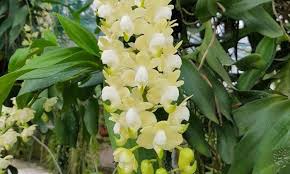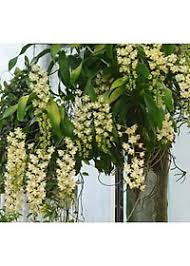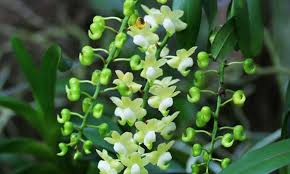
Quế Lan Hương, known scientifically as *Dendrobium anosmum*, is a tropical orchid prized for its exquisite beauty and intoxicating fragrance. Beyond its ornamental appeal, this remarkable plant holds a significant place in traditional medicine, particularly within various folk healing practices across Southeast Asia, including Vietnam. This article explores the medicinal uses of Quế Lan Hương in folk medicine, examining its historical applications, active compounds, and contemporary relevance in health and wellness.
## 1. Understanding Quế Lan Hương
### A. Botanical Characteristics
Quế Lan Hương is a species of orchid belonging to the Dendrobium genus, native to tropical and subtropical regions of Southeast Asia. It features slender stems that can grow up to a meter in length, adorned with beautiful, fragrant flowers that bloom in clusters. The flowers are often purple, white, or yellow, and they emit a delightful aroma, making them popular in ornamental gardening and floral arrangements.
### B. Cultural Significance
In many cultures, particularly in Vietnam, Quế Lan Hương is more than just a flower; it is a symbol of love, beauty, and resilience. Its delicate blossoms are often used in ceremonies and celebrations, including weddings and the Lunar New Year (Tet). However, its significance extends beyond aesthetics, as traditional healers have long recognized its therapeutic properties.
## 2. Historical Context of Quế Lan Hương in Folk Medicine
### A. Traditional Uses
The medicinal applications of Quế Lan Hương can be traced back centuries, with its usage documented in various traditional medicine systems. In Vietnamese folk medicine, this orchid is believed to possess various health benefits, including enhancing vitality, supporting immune function, and alleviating certain ailments.
### B. Folklore and Myths
Folk stories often celebrate the medicinal qualities of Quế Lan Hương, attributing it with the power to heal and protect. Local legends may depict healers using the orchid in concoctions to treat ailments or enhance overall well-being. Such narratives highlight the deep-rooted cultural significance of this orchid in the realm of health and healing.
## 3. Active Compounds in Quế Lan Hương
### A. Chemical Composition
The therapeutic properties of Quế Lan Hương are attributed to its rich chemical composition, which includes various active compounds known for their medicinal effects. Some key components include:
– **Alkaloids**: These compounds have been shown to possess analgesic and anti-inflammatory properties, making them useful in managing pain and reducing inflammation.
– **Flavonoids**: Known for their antioxidant properties, flavonoids help protect the body from oxidative stress and inflammation, contributing to overall health.
– **Phenolic Compounds**: These compounds exhibit various biological activities, including antimicrobial and anti-inflammatory effects, supporting the body’s immune response.
### B. Pharmacological Studies
Recent studies have begun to explore the pharmacological potential of Quế Lan Hương. Research indicates that extracts from the orchid may possess anti-inflammatory, antioxidant, and antimicrobial properties, aligning with traditional claims about its health benefits. These findings provide a scientific basis for the use of Quế Lan Hương in folk medicine.
## 4. Medicinal Applications of Quế Lan Hương
### A. Respiratory Health
One of the most notable applications of Quế Lan Hương in folk medicine is for respiratory health. Traditional healers often recommend the orchid for treating respiratory conditions, such as coughs, bronchitis, and asthma. The fragrant flowers are believed to have soothing properties that help alleviate symptoms and promote lung health.
#### How It’s Used
– **Herbal Teas**: Dried flowers of Quế Lan Hương are often brewed into herbal teas. The infusion is consumed to relieve coughs and respiratory discomfort.
– **Steam Inhalation**: In some practices, the flowers are added to boiling water to create steam. Inhaling the steam is thought to help clear congestion and soothe the respiratory tract.
### B. Boosting Immunity
Quế Lan Hương is also regarded as a natural immune booster in traditional medicine. Its rich antioxidant content helps enhance the body’s defense mechanisms, promoting overall health and resilience against illnesses.
#### How It’s Used
– **Tinctures and Extracts**: Herbalists may prepare tinctures or extracts from the orchid to support immune function. These preparations are typically taken in small doses to enhance vitality and promote overall wellness.
### C. Skin Health
The antimicrobial and anti-inflammatory properties of Quế Lan Hương make it beneficial for skin health. Traditional remedies often involve using the orchid to treat skin conditions such as acne, eczema, and minor wounds.
#### How It’s Used
– **Topical Applications**: Fresh or dried flowers can be infused in carrier oils, which are then applied to the skin to soothe irritation and promote healing.
– **Facial Masks**: In some folk practices, powdered dried flowers are mixed with honey or yogurt to create facial masks that nourish and rejuvenate the skin.
### D. Stress Relief and Relaxation
The calming aroma of Quế Lan Hương is often utilized in traditional practices for stress relief and relaxation. The fragrance is believed to have a soothing effect on the mind and body, promoting emotional well-being.
#### How It’s Used
– **Aromatherapy**: Essential oils extracted from Quế Lan Hương are used in aromatherapy to reduce stress and anxiety. Diffusing the oil in a space can create a calming atmosphere.
– **Bath Infusions**: Adding dried flowers to bathwater is a traditional practice to enhance relaxation and create a tranquil environment.
### E. Pain Relief
The analgesic properties of Quế Lan Hương make it a popular choice for pain relief in folk medicine. Traditional healers often recommend it for managing various types of pain, including headaches, muscle aches, and joint pain.
#### How It’s Used
– **Herbal Poultices**: Crushed flowers can be combined with other herbal ingredients to create poultices. These poultices are applied to painful areas for relief.
– **Infused Oils**: Infusing Quế Lan Hương in carrier oils creates a pain-relieving oil that can be massaged onto sore muscles and joints.
## 5. Preparation Methods for Medicinal Use
### A. Harvesting
To harness the medicinal properties of Quế Lan Hương, proper harvesting methods are essential. Flowers should be picked during peak bloom, preferably in the morning when their fragrance is most potent. Care should be taken to avoid damaging the plant, ensuring its continued growth and availability for future use.
### B. Drying and Storage
Once harvested, flowers should be dried in a shaded, well-ventilated area to preserve their medicinal properties. Properly dried flowers can be stored in airtight containers away from direct sunlight to maintain their quality for medicinal use.
### C. Preparation of Remedies
#### Herbal Tea
1. **Ingredients**: Dried Quế Lan Hương flowers, water, honey (optional).
2. **Instructions**:
– Boil water and remove it from heat.
– Add a tablespoon of dried flowers to the water.
– Steep for 10-15 minutes.
– Strain the tea and add honey if desired.
#### Tincture
1. **Ingredients**: Fresh or dried flowers, high-proof alcohol (such as vodka).
2. **Instructions**:
– Place the flowers in a glass jar and cover with alcohol.
– Seal the jar and store it in a cool, dark place for 4-6 weeks, shaking occasionally.
– Strain the tincture and store it in a dropper bottle.
#### Poultice
1. **Ingredients**: Fresh Quế Lan Hương flowers, other herbs (optional), water.
2. **Instructions**:
– Crush fresh flowers to release their juices.
– Mix with other herbal ingredients if desired.
– Apply the mixture to the affected area and cover with a clean cloth.
## 6. Modern Research and Validation
### A. Scientific Studies
In recent years, there has been a growing interest in validating the medicinal claims associated with Quế Lan Hương through scientific research. Studies have focused on its pharmacological properties, exploring its potential as a natural remedy.
– **Antioxidant Studies**: Research has shown that extracts from Quế Lan Hương exhibit significant antioxidant activity, supporting its traditional use for boosting immunity and overall health.
– **Anti-inflammatory Research**: Some studies indicate that the orchid’s compounds may help reduce inflammation, aligning with its historical applications for pain relief and respiratory health.
### B. Integration into Modern Herbal Medicine
As interest in natural remedies continues to rise, Quế Lan Hương is being integrated into modern herbal medicine practices. Herbalists and practitioners are exploring its potential as a supplement or ingredient in formulations for respiratory health, immune support, and skin care.
### C. Challenges and Opportunities
While the traditional uses of Quế Lan Hương are well-established, challenges remain in standardizing its preparation and ensuring quality control in herbal products. Ongoing research and collaboration between traditional healers and modern scientists can help bridge this gap, fostering a deeper understanding of the orchid’s therapeutic potential.
## 7. Conclusion
Quế Lan Hương is a remarkable orchid with a rich history of medicinal use in folk medicine. Its diverse applications range from promoting respiratory health and boosting immunity to enhancing skin health and providing stress relief. The orchid’s fragrant blooms not only captivate the senses but also embody the essence of traditional healing practices.
As modern research continues to explore the medicinal properties of Quế Lan Hương, there is an opportunity to validate and integrate its uses into contemporary health practices. By respecting traditional knowledge while embracing scientific inquiry, we can preserve the cultural heritage associated with this beautiful orchid and harness its potential for promoting well-being.
In a world increasingly drawn to natural remedies, the story of Quế Lan Hương reminds us of the profound connection between nature and healing, encouraging us to
appreciate and explore the treasures that the natural world has to offer. As we continue to uncover the secrets of this enchanting orchid, we honor its legacy as a symbol of health, beauty, and resilience in the realm of folk medicine.


